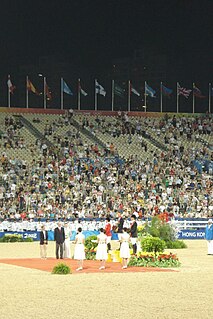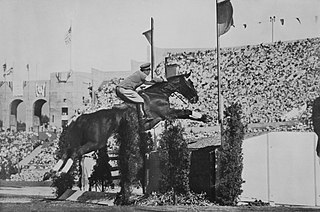
The equestrian events at the 1928 Summer Olympics included dressage, eventing, and show jumping. All three disciplines had both individual and team competitions. The competitions were held from 8 to 12 August 1928. Teams were now fielded by three riders, rather than four, the purpose being to reduce pressure on national federations to find that many riders in order to compete for team medals. Riders had to be considered amateurs, which was defined as either an actively serving professional officer, or as a gentleman rider as defined by the rules of that rider's national governing body. A total of 113 entries were present from 20 nations: Argentina, Austria, Belgium, Bulgaria, Czechoslovakia, Denmark, Finland, France, Germany, Hungary, Italy, Japan, the Netherlands, Norway, Poland, Portugal, Spain, Sweden, Switzerland, and the USA. This was the first appearance for Hungary, Japan and Argentina in equestrian events at an Olympics. Additionally, after being shut out from two Olympic competitions, Germany also returned to the Games to win a few medals in the equestrian events.
The team jumping was an equestrian event held as part of the Equestrian at the 1912 Summer Olympics programme. It was the first appearance of the event. Unlike the team eventing competition, the team jumping was not simply a sum of scores from the individual jumping competition. Instead, riders competed in the team event separately a day after the individual event. Different riders could be used in the two events, and teams were limited to 4 riders while each nation could send 6 individuals.

The individual eventing at the 2008 Summer Olympics took place between August 9 and 12 2008 at the Hong Kong Sports Institute.
The individual dressage at the 1928 Summer Olympics took place at Hilversum. The test was the same as for the 1924 Olympics, but the 10-minute limit was now raised to 13 minutes, giving the riders much needed time to complete it without losing points for going over the time allowed. Judging created controversy, both due to nationalistic tendencies by judges and the fact that individual judges had differing opinions on what was correct. While there was discussion on how to make it more fair—including dropping the lowest and highest scores, only having one judge from a neutral county, and removing 20 points from each score given to a countryman of each judge—no changes were made until after the judging scandal at the 1956 Games.
The team dressage at the 1928 Summer Olympics took place at Hilversum. Scores from the individual competition were summed to give results in the team competition. 1928 marked the first appearance of the team dressage competition, making it the last of the modern six-event Olympic equestrian programme to appear.

The individual show jumping at the 1928 Summer Olympics took place on 12 August 1928 at the Olympic Stadium in Amsterdam. Scores from the individual competition were summed to give results in the team competition. There were 46 competitors from 16 nations. Each nation could send a team of three riders; 15 nations did so, while Japan had a single rider. The event was won by František Ventura of Czechoslovakia, the nation's first medal in individual jumping. France earned its first medal in the event since 1912 with Pierre Bertran de Balanda's silver. Charles-Gustave Kuhn took bronze, putting Switzerland on the podium for the second consecutive Games.
The team jumping at the 1928 Summer Olympics took place at Amsterdam. Scores from the individual competition were summed to give results in the team competition.
The team eventing at the 1928 Summer Olympics took place at Hilversum. The event consisted of a dressage competition, a jumping competition, and an endurance test. Scores in each component were added to give a total. Scores from the individual competition were summed to give results in the team competition.
The team eventing competition was one of six equestrian events on the Equestrian at the 1992 Summer Olympics programme. Dressage and endurance portions of the competition were held at the Club Hípic El Montanyà, the stadium jumping stage was held at Real Club de Polo de Barcelona. The scores of the top three rider/horse pairs for each nation in the individual event were summed to give a team score.

The team eventing in equestrian at the 1932 Summer Olympics in Los Angeles was held at the Riviera Country Club (dressage), a specially built course in Westchester (cross-country), and the Olympic Stadium (jumping) from 10 to 13 August. NOCs were limited to three horse and rider pairs.

The individual show jumping in equestrian at the 1932 Summer Olympics in Los Angeles was held on 14 August. The event was called the "Prix des Nations" at the time. There were 14 competitors from 4 nations.
The individual dressage in equestrian at the 1936 Olympic Games in Berlin was held on the May Field from 12 to 13 August. German riders took the top two places, with Heinz Pollay winning the gold medal and Friedrich Gerhard the silver. The bronze was won by Alois Podhajsky of Austria.

The individual show jumping in equestrian at the 1936 Olympic Games in Berlin was held at the Olympiastadion (jumping) on 16 August. The competition was also referred to as the "Prix des Nations." There were 54 competitors from 18 nations, with each nation having a team of three riders. The results of the individual event were used for the team jumping event as well. The individual event was won by Kurt Hasse of Germany, the nation's first victory in individual jumping and first medal in the event since 1912. Romania and Hungary each earned their first individual jumping medals, the former with Henri Rang's silver and the latter with József von Platthy's bronze.

The team jumping or Prix des Nations at the 1952 Summer Olympics took place on 3 August, at the Helsinki Olympic Stadium. It was the eighth appearance of the event. For the first time, the event featured two rounds.
The team dressage at the 1956 Summer Olympics took place between 15 and 16 June, at the Stockholm Olympic Stadium. The event was open to men and women. The team and individual dressage competitions used the same results. Five judges gave scores, with the result being the sum of the scores. The three individual scores were summed to give a team score.
The team eventing at the 1956 Summer Olympics took place between 11 and 14 June, at the Stockholm Olympic Stadium. Eventing was open to men only. It was the 9th appearance of the event.
The individual jumping at the 1956 Summer Olympics took place on 17 June, at the Stockholm Olympic Stadium. The event was open to men and women. It was the 10th appearance of the event.
The individual eventing at the 1968 Summer Olympics took place between 18 and 21 October. The event was open to men and women. The competition included three segments: dressage, cross-country, and show-jumping. Penalties from each were summed to give a total score.
The team jumping at the 1968 Summer Olympics took place on 27 October, at the Estadio Olímpico Universitario. The event was open to men and women.
The team eventing competition was one of six equestrian events on the Equestrian at the 1984 Summer Olympics programme. Dressage and stadium jumping portions of the competition were held at the Santa Anita Racetrack in Arcadia, California, the endurance stage was held at Fairbanks Ranch, California. Scores from the top 3 horse and rider pairs for each nation were summed to give a team score; the lowest pair's score was dropped. Teams without at least 3 finishing pairs were not given a final score.







